Introduction
A study of the stages of development of modern society is the subject of many academic works in sociology, psychology, and social studies. To date, much knowledge has been accumulated that allows forming of valid conclusions about psychosocial trends. Thus, it can be said with great confidence that modern society is experiencing a severe impact of stressful factors. Indeed, this statement is very bold because it seems that it is reckless to claim a high level of stress in peacetime conditions in developed countries.
On the contrary, the absence of wars and economic prosperity has led to the fact that the average individual has many opportunities that were not previously available. Therefore, a modern resident of a developed country can freely travel, move and learn new branches of knowledge. Although these phenomena have a strictly positive orientation, the consequences of such a variety of choices can adversely affect the psychological state of a person. A strong stressful effect can be triggered by frequent moves or a radical change in professional activity. As a result, the individual experiences emotional depression and pressure, which leads to impaired activity.
A new workspace is associated with many risks. More specifically, this includes organizational, technical, and human aspects, the failure of which is detrimental to personal growth. A great solution to work overload is positive psychology, which considers the life of an individual through the spectrum of positive emotions. This branch of psychology studies models such as happiness, self-development, and success. It should be noted explicitly that positive psychology is not something pseudoscientific and poorly studied.
On the contrary, since this area of knowledge is relatively young, there are many concepts and contradictions in it. Many of the models already studied explore the mechanisms of an individual’s adaptation to stressful conditions, including a new workplace. In particular, positive psychology focuses on the fact that the individuals are creators of their fate, and therefore the levels of perception of stress can be significantly reduced.
This research paper aims to discuss the ideas of positive psychology as a tool for managing anxiety and stress in the context of a new job. It is assumed that the change of work lies either in the move of the employee to a new place and, as a result, new employment or a change of professional activity. This work is a useful generalization of well-known works that consider these issues from the point of view of statistical models. Therefore, the relevance of the research is not in doubt, and the work may be of interest not only to students and professors of the thematic areas of tourism and human resource management but also to any interested parties.
Theoretical Background
There are a large number of reasons underlying the natural stress caused by changing jobs. Moving or changing a professional activity in itself is a pretty energy-intensive event, which means that it takes a significant part of the individual’s vital forces and resources. Therefore, it is not surprising that a person may show general depression or emotional decline (Burch-Hubbard, 2020). However, the process and its consequences are essential for developing professional stress initiated by the move.
In an attempt to improve the quality of their lives, individuals often resort to serious decisions. Often, such actions can qualitatively change the level of comfort, although their implementation requires resources of time and effort. Dissatisfaction with the current salary, the desire for creative and professional growth, competition in the labor market, or an underdeveloped policy of support and motivation of the current management is often considered the main reasons for searching for a new job (NAKAMA, 2018).
At the same time, it should be kept in mind that the modern individual is rarely limited to the territory of a single city or even a country. On the contrary, if an employee represents a valuable high-intellectual potential, large companies are ready to compete for it (Gromozdova et al., 2018). Thus, individuals have the opportunity to travel around the world to those points where international organizations invite them. As a result, new professional paths open up for a person, but their implementation requires moving.
Self-study of a new workplace, accompanied by a move, carries a significant level of stress pressure for the employee. As a new member of the firm, an individual may encounter several new aspects that cause him to experience stress. In particular, the new office’s inconvenient location can be considered one of the critical factors. If the previous job was within walking distance, and it takes, for example, an hour to get to the new job, then this in itself can be a frustrating factor. In addition, it should not be forgotten that a new place of work is always associated with the construction of new social ties: both on the horizontal and vertical levels.
In other words, new employees will have to worry about whether they are doing well enough to demonstrate professional success in the eyes of management. Of course, this is severe stress caused by the problem of waiting (De Meza & Dawson, 2021). At the same time, there is no guarantee that the new working team will be friendly to the newcomer. If employees do not show friendship and positive behavior, the individual may be concerned about this instead of thinking about more effective solutions to professional problems.
Within the framework of the considered driving forces that initiate the development of stressful states of an employee, special attention should be paid to the person’s desire for stability. Many individuals do not want to change but are willing to work steadily for the same company for decades. It is appropriate to call this a comfort zone that people have built for themselves: when leaving it, the individual is expected to panic and strive to return (Emery, 2020). In the workplace context, a new employee of the firm may miss the previous office, the boss, or the work team, which also hinders the efficient performance of professional tasks.
All this together forms a severe layer of factors that determine the path of development of the psycho-emotional dynamics of an individual when moving to a new place of work. Recognizing the above aspects as part of the big problem of low professional productivity, company leaders should find universal solutions. One of these solutions stems from positive psychology, a harmonious symbiosis of the philosophy of a happy life, and a set of rules for overcoming harmful and stressful conditions.
Positive emotions are one of the primary means of getting rid of depression, anxiety, and other diseases. Adherence to such views forms a section of modern psychotherapy based on the study and application of positive personality traits of the individual. In particular, positive psychology is based on the belief that strengthening the affirmative qualities of a person will improve and accelerate the development of society. In the context of the research problem under consideration, positive psychology serves as a set of well-known mechanisms and tools that competently manage stress and respond to the worker’s psychosocial challenges promptly.
Although many well-known theorists, including Maslow and Rogers, made significant contributions to forming the center for positive psychology, special attention should be paid to Martin Seligman. Thanks to Seligman’s efforts, positive psychology secured its status as an academic discipline (Titus, 2017). By conducting numerous social studies and surveys among respondents, Seligman was eventually able to formulate four key character traits that contribute to achieving happiness. Love, hope, gratitude, and curiosity stood out among them. Interpreting these words differently, a person whose personality would have all four attributes equally would have an increased chance of achieving life happiness.
Based on the previous description of the central paradigm of positive psychology, it can be seen that its theorists operate with categories of internal human resources and the use of specific forces to create a positive agenda. A positive perception of the world allows mobilizing of internal resources. Specifically, channeling the free energy to solve a problem rather than plunging into a negative influence increases the chances of successfully overcoming a crisis. The ability to find positive moments helps to avoid despair and to maintain stable common sense. At the same time, it allows to qualitatively improve the social component of an individual’s personal life by increasing the new human relationships. Thus, it is much easier for people who are positive to establish contacts. The more positive individual can achieve the most remarkable career success in social groups of different sizes.
Research Questions & Hypotheses
Recognizing the undoubted reputation of positive psychology as a tool for solving complex life problems, including stressful situations when changing jobs, it is essential to conduct a critical study of its effectiveness. The subject of this research is to test the limits of the permissibility of positive psychology as a mechanism for managing work stress, and therefore it is crucial to create a list of research questions that are answered in the work:
- What can positive psychology offer for dealing with the stress of a new job?
- How can the company’s management use the ideas of positive psychology to form a working culture?
- Is positive psychology more effective than other tools?
- Is this area sufficiently studied, and can the published results be fully trusted?
- Finally, does the industry in which positive psychology has been attempted matter?
The answers to these questions were related to the objectives of this study. It should be emphasized that the search for answers to the above statements is not an end, but on the contrary, it allows the creation of a more extensive and comprehensive document aimed primarily at studying the three working hypotheses. The following hypotheses were formed for this research work:
- The workplace of employees, modified according to the ideals of positive psychology, improves the indicators of professional efficiency.
- To overcome stressful situations during a workplace change, an employee can use concepts and models of positive psychology.
- The company leader is of great importance for the formation of a culture of positive psychology in the workplace.
Methods
The basic instructions include conducting independent statistical tests and examinations that allow making a critical assessment of the collected quantitative data. In other words, the research methodology should be based on the use of standard statistical models. This idea was used to develop a unique academic strategy that allows operating on the results of quantitative statistical research and generalizing and comparing data. A literature review of relevant thematic sources was chosen as the primary research tool. In this regard, several assumptions should be discussed in advance.
It is important to note that there is no single sample used for this study. In fact, for the analysis in the literature review, twenty sources were used, with a time interval from 2002 to 2021. As it can be seen, this is a relatively small spread, and therefore it can be stated that the selected materials meet the criteria of relevance and novelty. However, a specific part of the research consisted of classical quantitative materials using their sample sizes and types. Thus, this study is secondary and therefore operates on already collected data.
It should be noted that the procedure for searching for materials was fully implemented through the Google Scholar digital platform. The basic search strategy included the use of the keywords shown in Table 1. Narrowing the time limits to publication over the past five or ten years was not an effective procedure, so the optimal range of publication dates was from 2000 to 2021 inclusive. Besides, the mandatory criteria for selecting materials were writing in English and the relationship between positive psychology and work trends. Finally, another important criterion for selecting materials was the functional ability to read a full-text document, available either free of charge or by university subscription.
Based on the above, it can be concluded that the current study may have some limitations related to the choice of literature data. Due to that, not all of the valuable works could be in the final sample. This limitation should be taken into account when scaling the results discussed in the following sections. The research methodology meets the basic standards of the classical literature review, and therefore there is no reason to doubt the reliability of the critical assessment.
Table 1. Keywords for searching literary data.
Results
An intriguing part of the methodological development of the study was the academic relevance of the data discussed. It was necessary to avoid a situation in which deep research and critical analysis of interest issues would not have any scientific evidence. In such a scenario, this would mean a general failure of the project. Popularity was determined using the online tool Web of Science by the keywords “positive psychology” and “new work”. Figure 1 shows that these combinations are popular for several scientific branches at once, although the absolute majority of works are written in the category of multidisciplinary psychological research. Interpreting these results, the study of the effects of positive psychology on resource management in the new workplace is a very relevant and discussed topic.
Additional interest was generated by identifying the nature of this popularity. It was expected that the demand for relevant publications should be growing. Otherwise, the study would be of a retrospective nature since it would critically evaluate the data that is no longer relevant. Figure 2 describes that the dynamics of citations for these queries increase, with each year having a comparably more significant number than the previous one. In other words, the study of the possibilities of applying positive psychology to the management of work stress in the context of moving is a topic that is gradually gaining interest in society.
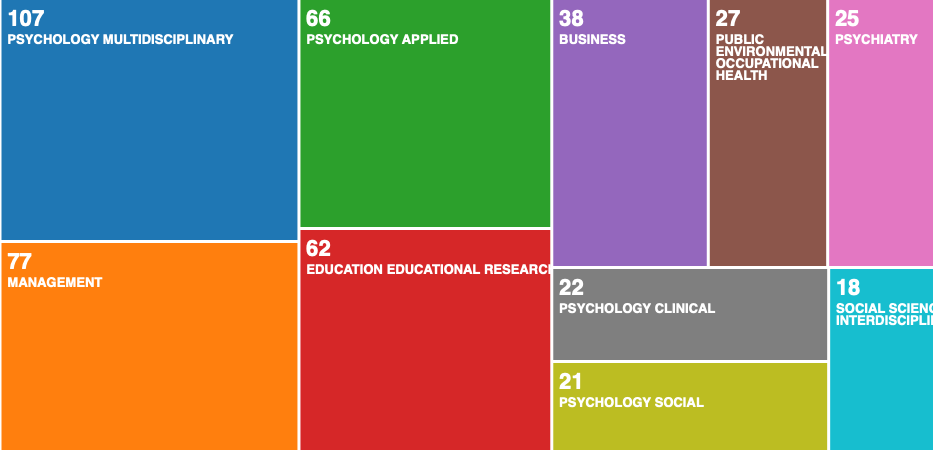
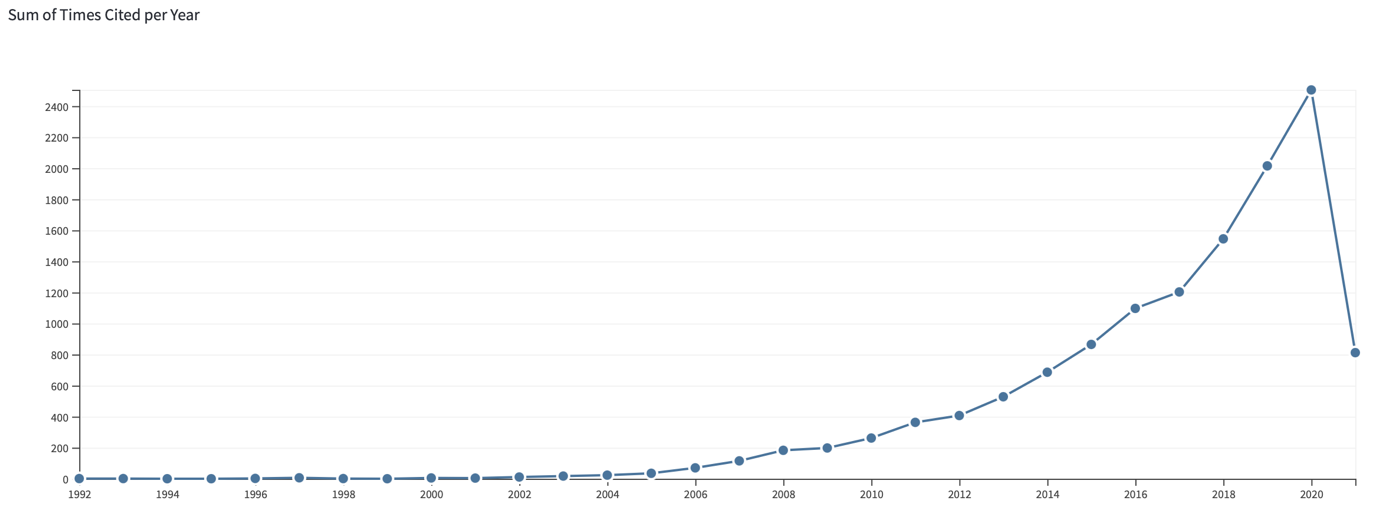
Moreover, it is essential to note that not all the sources found were used as materials for writing a literary review and an answer to working hypotheses. The search add-ons described in the previous section allowed the collection of more than 84 relevant research papers initially. However, only fourteen percent of them (no = 12) were used. The fact is that most of the materials were not filtered by reading because if a person does not cursorily read the conclusions, it became clear that they are not applicable within the framework of the topic under study. Furthermore, about twelve percent of the sources found had limitations, including either a small sample size or poor quality of the selection of respondents. Therefore, to inhibit bias, it was decided to leave a minimum amount of valuable materials.
Testing of the First Hypothesis
It must be recalled that the statement of the first working hypothesis linked the increase in the efficiency of employees in the office and the use of a culture of positive psychology. The core of this statement is that personal effectiveness is a dynamic metric and depends on many factors. Since stressful states have the potential to suppress an individual’s motivation and confidence, it is appropriate to conclude that the stressful effects of a forced transfer to a new workplace can be suppressed by positive psychology.
The reference to literary sources allows confirming these arguments. For example, O’Connor & Grant (2018) develop the concept of a positive workplace environment (PBWE), which allows employees to achieve high career results. PBWE is not a specific type of office or employee relationship system but an organizational philosophy that uses a holistic approach (Figure 3). Thus, the reformatting of classic office spaces into open, environmentally friendly ones (Figure 4) has increased employee productivity by nineteen percent (Grant, 2019). According to the authors’ calculations, personal productivity in solving cognitive tasks in a modified office environment increased by sixty-one percent. On the other hand, researchers have found that when the needs for autonomy, competence, and conformity are ignored, productivity is comparably reduced.
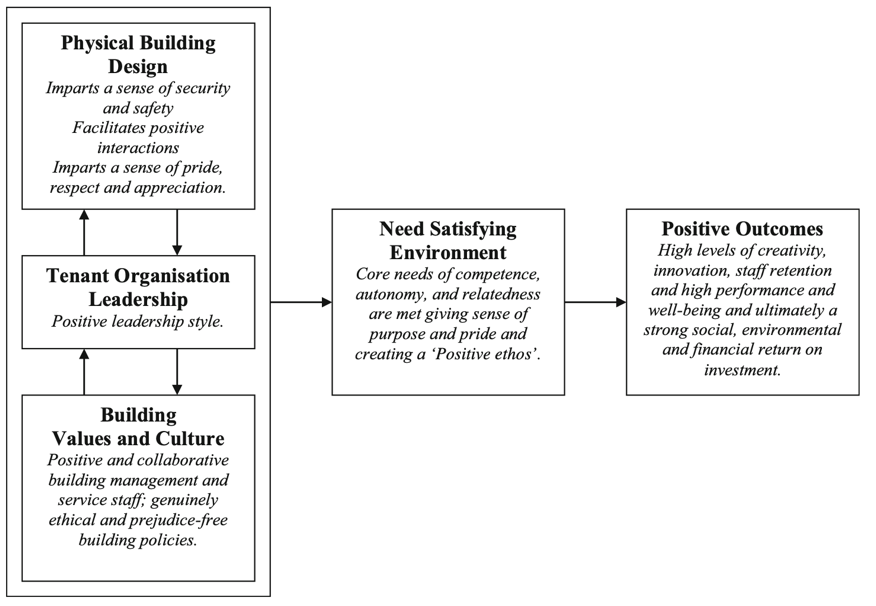
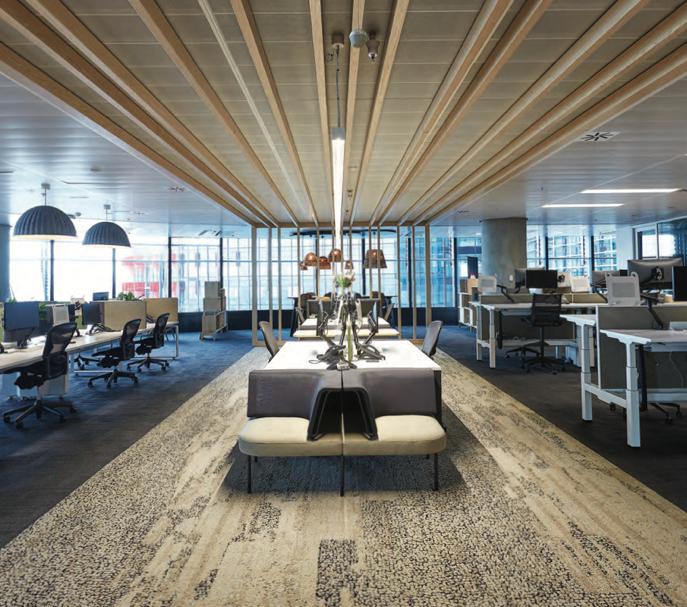
Furthermore, interesting results were found in a study comparing the productivity of employees in collaborative office spaces, called coworking. Since the use of combined spaces for open work of all categories of employees is becoming an increasingly relevant trend of the era, an early study of their effectiveness was necessary. More specifically, Morrison & Stahlmann-Brown (2020) were able to statistically prove that coworking does not meet expectations and significantly increases the level of employee distraction from work tasks (Figure 5). On the contrary, to improve operational efficiency, offices should have a zonal differentiation so that each area can correspond to a specific task being solved.
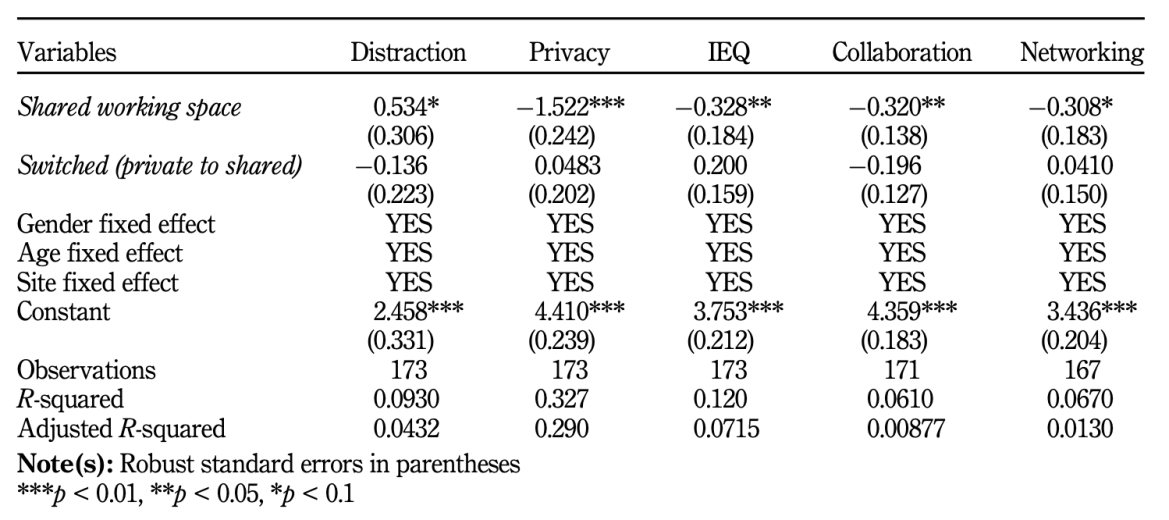
An excellent generalization for the first hypothesis can serve as a work that explores the possibilities of applying positive psychology concepts at work. Turner et al. (2002) discussed the effectiveness of implementing the ideals of this area of psychotherapy at work to maximize employee engagement and productivity. One of the most significant research results was the healthy work model, which describes all the necessary and vital features that a company must possess to meet the positive psychology agenda depicted in Figure 6.
Thus, it should be said that using the idea of positive psychology to increase productivity has an excellent result. Three scientific papers have shown that this form of psychology improves professional performance, which means that its practical implementation should be a priority for companies. It also follows from the results that the formation of positive company culture will allow the new employee to survive stress better and become a full-fledged part of the work team faster.
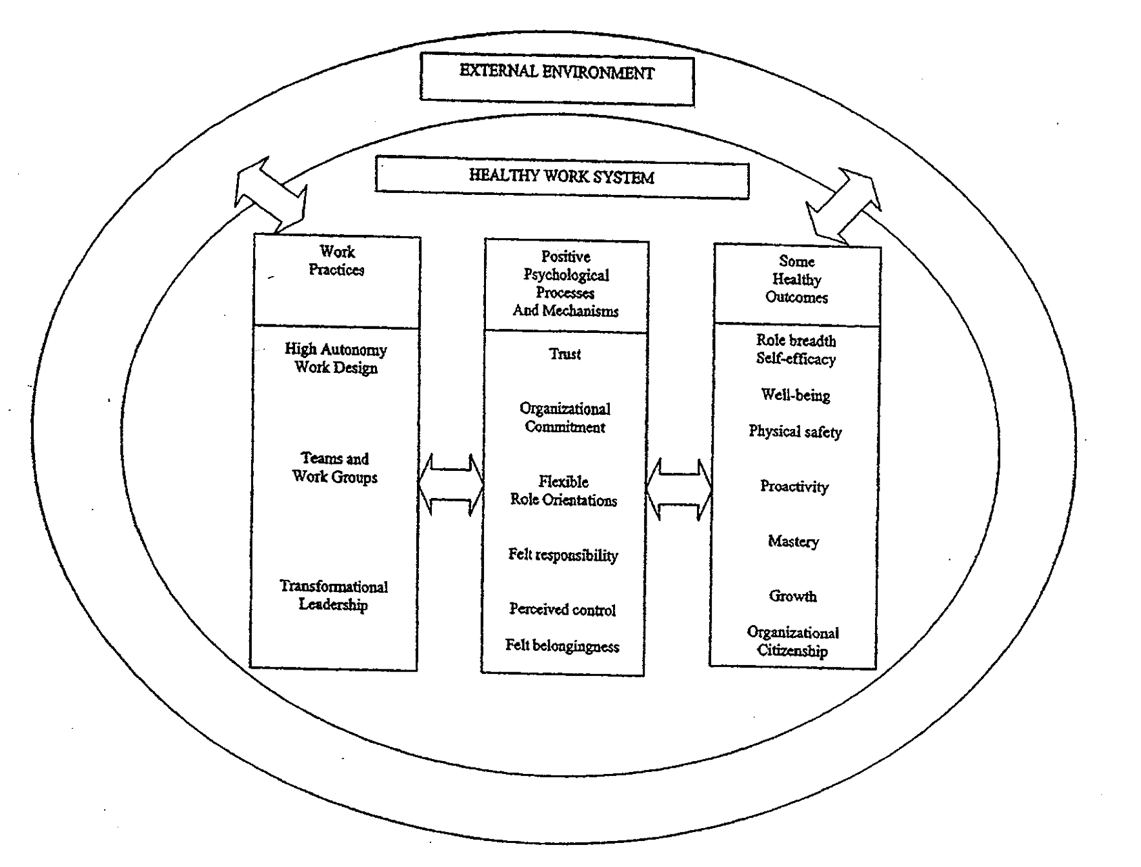
Testing of the Second Hypothesis
It should be recalled that the second hypothesis concerns the relationship between how the workplace stress caused by moving is managed and the use of positive psychology strategies. In contrast to the previous hypothesis, this statement was aimed at internal ways of eliminating stressful states. The causal relationship in this context was built on the assumption that a person can independently overcome negative moments and manage the perception of undesirable factors to increase the level of their happiness at work.
It must be recognized that, in reality, the work environment is potentially dangerous for a new or transferred employee because it offers several threats. First of all, this applies to burnout, psychological or physical violence by colleagues and managers, theft, and a general sense of insecurity (Tanku & Tanku, 2021). It was expected that positive psychology allows the creation of a culture in which each employee knows how to manage negative states. Consequently, the company is interested in such an outcome since each employee personally controls their productivity, which means that organizational metrics are growing.
Sources generally agree on what mechanisms can be used to manage individual states. More specifically, standard suggestions include developing a professional growth mindset, regular reflection, or building complete confidence in oneself and judgment (Thackray, 2018; Nelson & Simmons, 2003). However, data on the effectiveness of specific practices vary between studies. So, Mongrain & Anselmo-Matthews (2012), who repeated Seligman’s landmark study, showed that performing individual positive psychology exercises can be overestimated because their actual effect is significantly less, as shown in Figure 7.
At the same time, it is essential to note that there is a difference in general, and its insignificance cannot be a sufficient guarantee of the absence of any effect. In contrast, studies at Cabezas-Heredia (2021) showed that training programs built on the foundation of positive psychology significantly reduced the level of stress in employees to low. In other words, to date, there is no specific data on the effectiveness of positive psychology for relieving stress states. The difference in the results is justified by the significant difference between the research approaches and the cultural background of the authors.
On the other hand, it is well known that communication is often an excellent tool for overcoming stressful conditions. During communication, a person can remove unnecessary emotional stress and find support (Van Geert, 2019). For the work environment, communication is also of fundamental importance since effective communication between employees has benefits both in improving the personal condition of the novice employee and the operational productivity of the entire department. Therefore, communication between colleagues should be encouraged as an active tool of positive psychology. Mayer (2019) came to the same conclusion: creativity should act as one of the main priorities of organizational management, encouraging employees to cooperate constantly. It was shown that the more developed the culture of cooperation, the better for the company.
Based on the above, it is appropriate to conclude that the employee can use positive psychology strategies to eliminate the undesirable consequences caused by moving and starting a new career. Such measures include personal reorientation of priorities, affirmations, intensification of communication, and attitudes to professional growth. Although data on the ultimate impact of the programs differ, there is no doubt that, in general, they can have the desired effect.

Testing of the Third Hypothesis
Finally, the last working hypothesis was to determine the relationship between effective leadership and creating a culture of positive psychology. This suggestion applies to the personal desire to manage the situation around the individual or the physical transformation of the office and the positive pressure from the management. The implication is that an effective leader can create a discipline in which each employee will sensibly use internal and external resources to manage stressful conditions and inhibit professional burnout. Thus, the general idea of this statement is reduced to the competent skills of the leader to competently create an organizational culture to favors each employee’s professional experience.
Many academic authors have studied the relationship between effective leadership and the practice of positive psychology. For example, Lewis (2011) wrote about creating a favorable vector for the company’s development. The academician noted that a kind, friendly attitude, realized through respect and generosity, positively impacts employees. On the contrary, if the priority of management is not the formation of a constructive environment but the prevention of deficits and the fight against shortcomings, this approach shows lower organizational efficiency. It follows that in order to maximize the benefits of employees (which means increasing engagement and working with motivation), the leader must strive to build a positive environment.
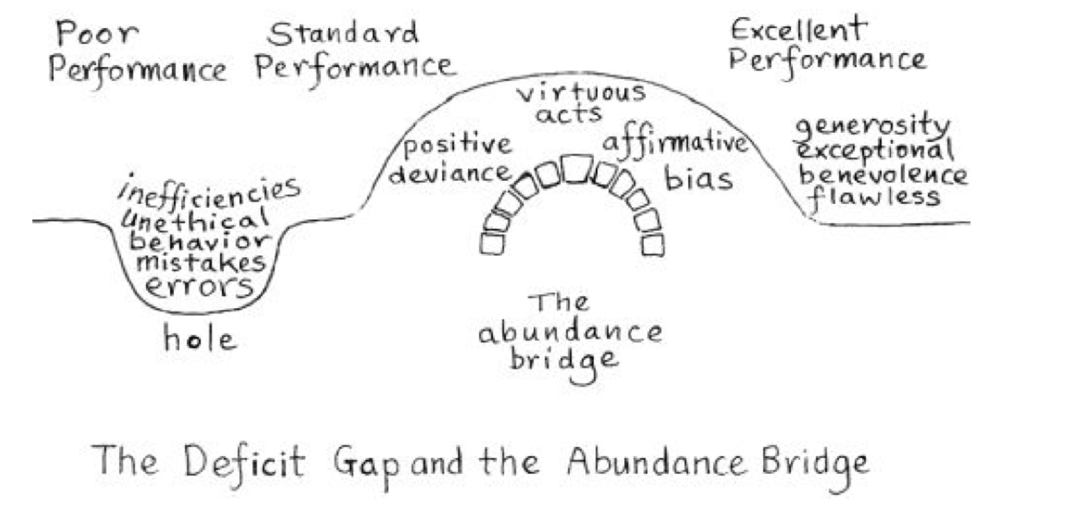
At the same time, it is known that the range of responsibilities of the manager includes the creation of an enticing system of motivation and retention of current employees so that they voluntarily wanted to bring the company financial well-being. For example, Gulyani and Sharma (2018) have shown that personal perception of reward programs makes a significant contribution to job satisfaction and increased engagement. From the perspective of positive psychology, this result may indicate that with greater awareness of financial and moral well-being programs, the individual can make more outstanding professional efforts. In other words, people are willing to try when they know exactly what their benefits are and how this will affect happiness. It is interesting to emphasize that happiness, in this case, should not be perceived as achieving only financial well-being.
On the contrary, it is a mistake to think that money is the primary motivator to overcome the stress of changing jobs. The data from Figure 9 shows that monetary rewards had a minor effect on the perception of happiness, while non-monetary motivation systems, on the contrary, had a more significant effect. To put it another way, Gulyani & Sharma has shown that one of the main driving forces of an employee is a competent policy of motivation from the leader. As a result, an effective leader should be interested in developing a full-fledged program to increase the personal involvement of subordinates and, as a result, improve operational efficiency.
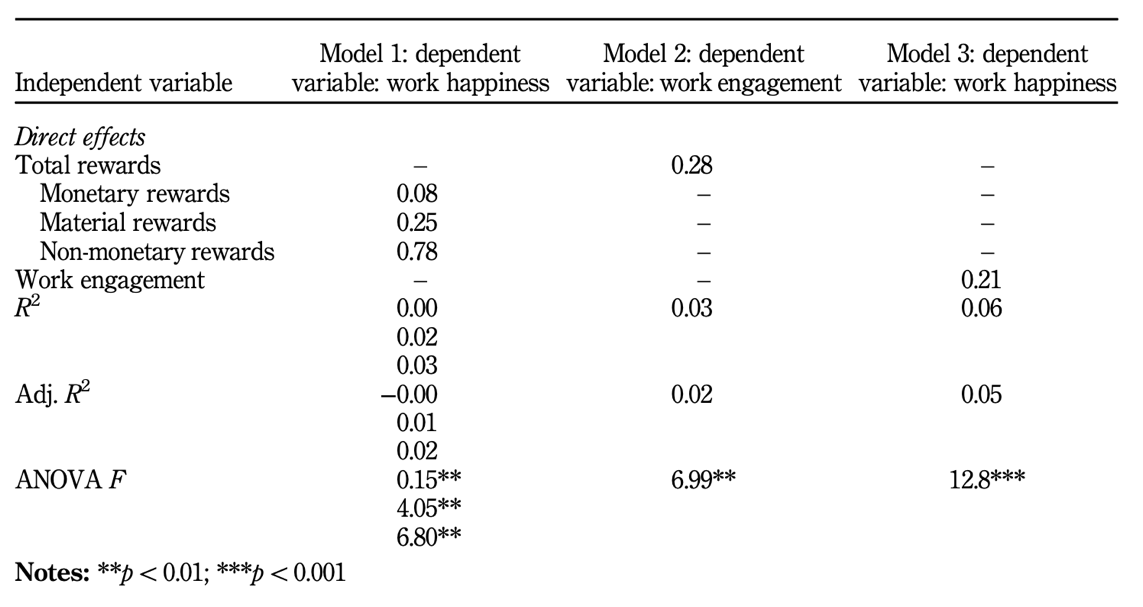
Discussion
In this paper, it is recognized that changing the workplace is a severe challenge for the individual. Provoked either by moving to another city or changing the professional sphere, changing work causes stress in a person. An individual may be concerned about their new social position, work responsibilities, or the need to meet new people; thus, with poor management and self-control, changing jobs can lead to a psychoemotional crisis. In order to properly control the situation and take timely decisions, the ideas of positive psychology can be relevant.
To be more specific, positive psychology as a separate discipline offers a person the use of positive, favorable settings and affirmations. Belief in the best and hope for excellent results accompany personal transformations, so positive psychology is more than just self-suggestion. In this research paper, it was confirmed that positive psychology has a real chance to help a person in the conditions of work stress. At the same time, there was no single instruction on the use of psychological practices. Positive psychology offers a wide range of manifestations, including the physical transformation of office buildings, the development of an employee motivation program, effective leadership, and the use of internal mechanisms. All the results are valid generalizations of disparate psychological data and can be helpful for managers and leaders.
At the same time, it should be noted that although the literature review in this work was carried out following all the requirements, the results obtained cannot be called entirely reliable. In particular, the list of works for the study was limited only to literature in English published in the last twenty-one years. In addition, not all of the discovered works were used because they did not entirely fit the topic of the study. Moreover, a specific part of the work used was based on quantitative methods of analysis, but each source’s reliability cannot be fully confirmed. Thus, the general limitations to this research project are reduced to the possibility of reducing the quality of the reviewed data. Therefore, future research should expand the inclusion criteria for educational materials and explore a broader range of valuable papers.
References
Burch-Hubbard, L. (2020). Managing stress in a constantly-changing workforce. Web.
Cabezas–Heredia, E. (2021). Positive psychology program: Stress and coating. Turkish Journal of Computer and Mathematics Education (TURCOMAT), 12(3), 4504-4512.
Clarivate Analysis. (2020). Web of Science. Web.
De Meza, D., & Dawson, C. (2021). Neither an optimist nor a pessimist Be: mistaken expectations lower well-being. Personality and Social Psychology Bulletin, 47(4), 540-550.
Emery, S. (2020). Stepping out of your comfort zone. British Journal of Nursing, 29(1), 55-55.
Grant, A. M., O’Connor, S. A., & Studholme, I. (2019). Towards a Positive Psychology of buildings and workplace community: The positive built workplace environment. International Journal of Applied Positive Psychology, 4(1), 67-89.
Gromozdova, L., Derbenova, Y., & Tsiupa, A. (2018). International tourism impact on economic development of countries. Web.
Gulyani, G. & Sharma, T. (2018). Total rewards components and work happiness in new ventures. Evidence-based HRM, 1-19.
Lewis, S. (2011). Positive psychology at work: How positive leadership and appreciative inquiry create inspiring organizations. John Wiley & Sons.
Mayer, C. H. (2019). Key factors of creativity and the art of collaboration in twenty-first-century workspaces. Thriving in Digital Workspaces, 147-166.
Mongrain, M., & Anselmo-Matthews, T. (2012). Do positive psychology exercises work? A replication of Seligman et al.(). Journal of Clinical Psychology, 68(4), 381-389.
Morrison, R. L., & Stahlmann-Brown, P. (2020). Perceptions and performance of knowledge workers transitioning from single-cell offices to shared workspaces: evidence from panel data. Journal of Managerial Psychology, 1-16.
NAKAMA Global. (2018). 7 reasons to look for a new job! NAKAMA. Web.
Nelson, D. L., & Simmons, B. L. (2003). Health psychology and work stress: A more positive approach. Web.
O’Connor, S. A., & Grant, A. M. (2018). Positive psychology meets real estate: The positive built workplace environment. Corporate Real Estate Journal, 8(2), 136-153.
Tanku, P., & Tanku, G. (2021). Sources of stress at work. Review Of Management & Economic Engineering, 20(1), 1-10.
Thackray, G. C. (2018). Positive psychology in the workplace. Thrive Global. Web.
Titus, C. S. (2017). Aquinas, Seligman, and positive psychology: A Christian approach to the use of the virtues in psychology. The Journal of Positive Psychology, 12(5), 447-458.
Turner, N., Barling, J., & Zacharatos, A. (2002). Positive psychology at work. Handbook of Positive Psychology, 52, 715-728. Web.
Van Geert, J. A. G. (2019). Employee benefits: a qualitative research study on the perceptions of HR-professionals with a strategic point of view on the use of flexibility, communication and employee involvement. Web.
